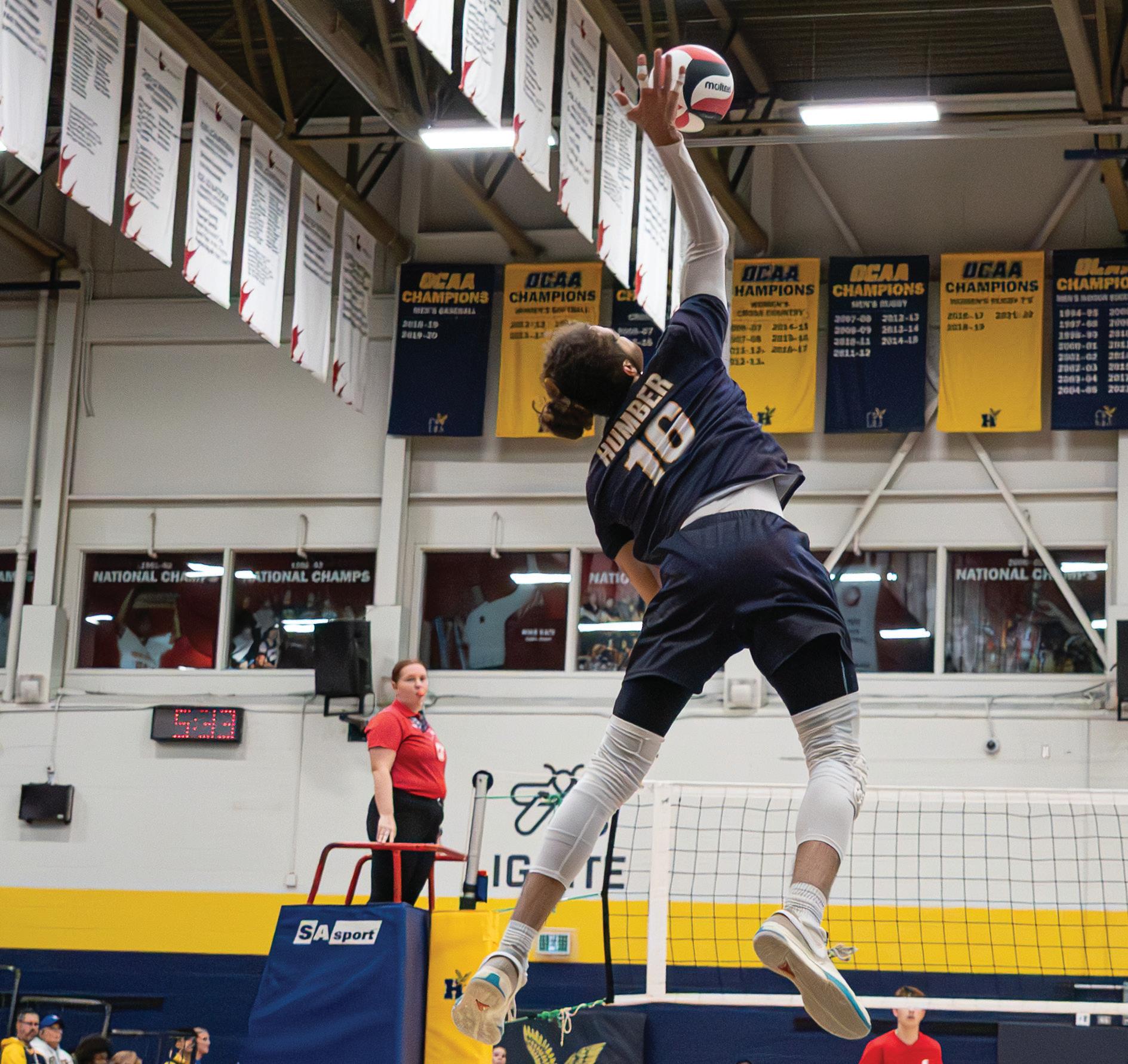HUMBER ET CETERA
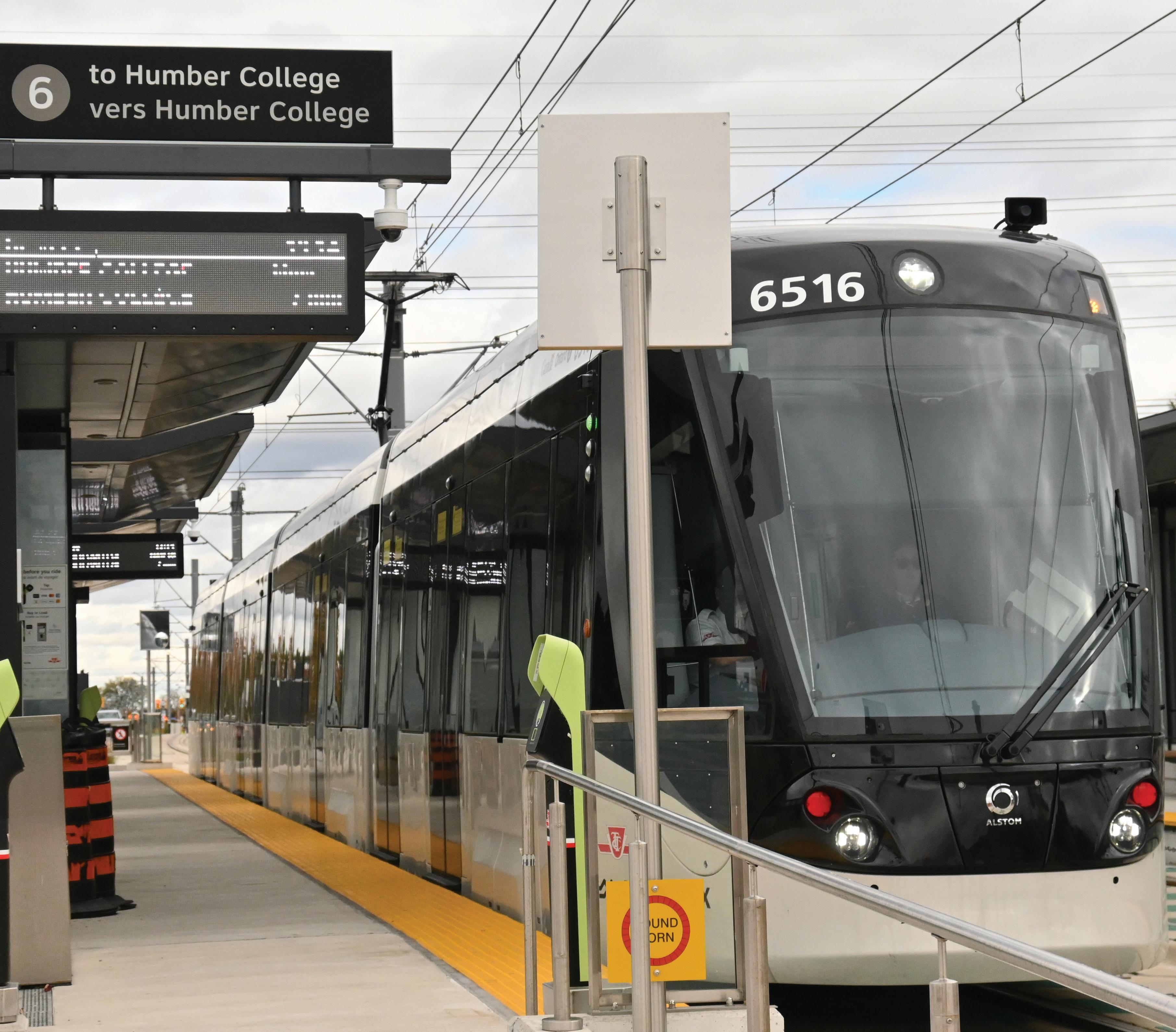




Joseph Zago HumberETC News
OPSEU’s full-time support staff have ratified a new three-year contract. The deal, reached last month after a five-week strike, gives a total of 6.25 per cent in wage increases over three years.
The new deal expires Aug. 31, 2028.
OPSEU said 89 per cent of the approximately 7,800 members who voted on the tentative agreement supported the new pact.
The deal includes improvements to health care and shift premiums.
The strike ended on Oct. 15 after mediation.
One of OPSEU’s demands during negotiations had been to restrict contracting out and protect bargaining unit work from management. However, the CEC claimed the collective agreement already protected employees from losing their jobs from direct contracting out.
The new contract will provide an extended timeline for employees who take a leave of absence to work for a contracted company outside of the institution.

Support staff workers striking at North campus bus entrance on Great Hawk Road on Sept. 11.
The agreement also said fulltime support staff will receive a shift premium improvement.
OPSEU said in a news release that although it did not achieve the full restriction of contracting out work and managers fulfilling support staff obligations, it will push for this initiative in future rounds of bargaining.
CEC said in a news release that
all college workers must be able to help students, and managers doing support staff work are not a threat to support staff job security.
Meanwhile, 64 per cent of parttime support staff have voted in favour of giving their bargaining team a strike mandate.
OPSEU is asking for a fair wage increase, paid sick days, time off for religious holidays, and other
items such as job descriptions and feedback for unsuccessful interviews. Part-time staff have been working with an expired contract.
Negotiations are expected to begin Nov. 20.
Meanwhile, OPSEU is also negotiating a first contract for part-time and sessional faculty following a 20-year effort to organize them.
Humber will charge students a $150 late fee if they don’t register for the Winter 2026 semester on time.
This email announcement from the registrar’s office was sent to students on Wednesday, Nov. 4.
Humber Media Relations and External Communication Specialist, Chad Derrick, said the
decision to reinstate late registration fees was made because of increased administrative resources needed for manual registration and to make sure class schedules were processed in time.
Humber used to charge a flatrate late fee for overdue payments, which was removed temporarily in 2021 due to COVID-19.
Don Rafael Carlos Ruiz, an international student studying Mechanical Technique – Mill-

wright, said he feels he is being cheated as he pays three times more than domestic students.
“I pay via my credit card back home, so I get additional charges for it,” he said. “They have the guts to charge me an additional $150. It’s money-making, it’s just business.”
First-year mechanical engineering student, Manoush Faisal, said she is confused by why she needs to pay for the late fee as a diploma student, but it doesn’t apply to some bachelor’s degree students.
“It’s weird. If you’re gonna give it to everyone, why is it only certain degrees and certain degrees don’t? So I think that’s very hypocritical,” Faisal said. “If you’re trying to get us to pay on time, why is an exception to the Bachelor of Mechanical Engineering?”
Derrick said in an email that the exemptions have been made for programs that traditionally register later, due to testing or clinical placement assignments, which must be completed before registration.
Some students said they understand the late fee.
Third-year sport manage-
Humber Et Cetera is the Humber Polytechnic journalism program laboratory newspaper. It is created by journalism students in the Advanced Diploma program. Et Cetera
Parthvi
ment student Bryan Beserra said it’s easy to find classes unless they’re block-based or they have to choose their own, since some students have to reach out to their coordinator when they can’t find the class on the registration portal.
Beserra thinks $150 is excessive for a late fee, but at the same time, it’s the students’ responsibility to register their classes on time.
Faisal said the fee was a surprise.
“It can definitely be a barrier for a lot of people applying and trying to continue their studies. Because an extra $150 on top of all the fees is not something people expected in the first place,” Faisal said.
“Unless they can tell us exactly what it’s going to be, why they need it in particular. It’s an incentive to pay on time,” she said, asking for more transparency from Humber.
Derrick said the late fee will not be applied to 2025/26 firstyear students.
Winter registration runs from Nov. 17 to 20, with each program having a designated time slot.

The Finch West Light Rail Transit (LRT) officially completed its testing phase and will start running to the Humber North campus on Dec. 7.
Vanessa Anna, a second-year esthetician and spa management student, said she is overjoyed to hear the Finch LRT will open.
“No way, I am happy! It’s definitely going to be way easier commuting to other places. After school is going to be much more efficient because it’s going to be faster, and I feel like it will be way better in general,” she said.
The LRT runs 10.3 kilometres and makes a total of 18 stops, including both the starting point at Finch West Station and the ending point at Humber Polytechnic North campus. The line will interconnect at several stops with MiWay, York
Region, Brampton, and GO Transit. Construction for the LRT began in 2019 and was expected to be completed by 2023.
The two-year delay in completion has been frustrating for commuters.
Anna uses public transit three days a week to get to campus and said taking buses has taken a lot of her time.
“I use public transit on the days I go to school, Monday, Tuesday and Wednesday. It has caused me to be late to certain events, whether it’s work or anything I have to go to,” she said.
“It just is very time-consuming, I just hate being on the bus for so long,” Anna said.
“My commute is an hour long. I take the 50 TTC bus to Islington Station and from there, I take the Subway Line 2 to Kipling, and lastly, I take the 947 Express TTC bus to
get to Humber North campus,” she said.
The federal government has contributed $333 million to the $1.2 billion Finch LRT project.
The Ontario Green Party Kitchener Centre MPP, Aislinn Clancy, an advocate for public transit, said not having enough of it to offer can be costly for students.
“If you are spending hours and hours on transit because you don’t have the convenience of accessible transit, it makes your studying experience really difficult,” she said.
Commuters will save more time travelling to their destinations with this added route. The Ministry of Transportation said the LRT will travel at 60 km/h and is 34 minutes from the starting point at Finch West Station to Humber North. Clancy also encourages methods of travel that decrease emissions into the environment.
“We know that transportation is such a huge part of our emissions because the most inefficient way to travel is by one person sitting in one car, sitting in traffic,” she said.
“The more people we can put onto transit, so they don’t have a soul-crushing commute, but they also emit less. It’s a good quality of life investment but is also a good climate investment,” Clancy said.
“It’s a better way to move people around. It alleviates congestion, which is a huge issue, and it is just more sustainable,” she said.
TTC communications specialist Stuart Green said TTC could not comment because the commission does not have operational control of Finch LRT yet.
The Eglinton LRT is also undergoing trial testing, so Metrolinx and TTC can evaluate the safety, timing, and any additions or fixes that need to be made.


Third-year Meghan Aucoin played an important role for the Humber Hawks women’s rugby team this season.
The winger recorded a career-high 130 points with 18 tries and 20 converts.
Aucoin’s growth from her rookie year with 20 points to becoming the OCAA Defensive Player of the Year shows the hard work and dedication needed for an athlete to reach the top.
“I feel like I put in a lot of work, not just on the field, but outside in the gym,” she said. “It definitely means so much to me. I’ve tried a lot harder in the past few years, just trying to perfect my craft.”
Born in Port Perry, Ont., Aucoin said she didn’t start playing rugby until high school after initially focusing on hockey.
“Hockey got too busy, and rugby was just more what I was interested in,” she said.
Aucoin said the semifinal game against the Conestoga Condors this season was a turning point in her rugby career.
“That was probably one of the most intense games of my entire life and my entire career as a rugby player,” she said. “It was back and forth the entire game, very defensive.”
Entering her final year next season, Aucoin hopes to leave a legacy for her leadership and commitment to the team.
“I want people to know that I’m very dedicated,” she said. “Humber rugby means so much to me.”tant.
Samuel Brito and Annays Medeiros Senior Reporters
Family visits are meant to reconnect with loved ones, and it's an opportunity to get in touch with relatives, friends, and return to one’s roots.
However, Mother Nature had other plans for Humber Polytechnic international Biomedical Sciences student Gabrielle Sterling when she visited her family in Jamaica during reading week, just days before Hurricane Melissa’s landfall assault on the island.
She described the before and after of some places on the island as the hurricane went through the nation.
“It was just so beautiful," she said. "It's just unrecognizable now.”
Melissa was a recordbreaking Category 5 hurricane that crashed into the Caribbean.
At the moment of landfall in western Jamaica, its winds were
most of the storm, and while they were spared from the worst, Melissa’s impact was felt throughout the island.
She said some family members lived closer to where the hurricane made landfall, and she couldn’t hear back from them.
“I remember being there and not being able to hear from my aunts and my uncle, who lives in a different parish,” she said.
“We didn't hear from them in about three days.”
She also mentioned her flight was cancelled on the morning of Oct. 26 due to Melissa’s approach.
“It's the anticipation what made everybody worried,” Sterling said. “I think that was the most dreadful part of the whole experience because the hurricane was at sea for so long.”
The hurricane also affected students away from home whose family resides in Jamaica.
Among them is Stephaun Clarke, a Media Communication student
worst one for him.
Now with Hurricane Melissa, Clarke said some of his family members couldn’t get in touch with him because of power outages, as trees were blown down in the yard, and roofs were leaking, but the ones he contacted are doing good.
“JUST HEARING THAT, OKAY, IT'S COMING ON SATURDAY. THEN, NO, IT'S COMING ON SUNDAY. THEN, NO, IT'S COMING ON MONDAY. I WAS A LITTLE BIT UPSET, ”
- Gabrielle Sterling
The hurricane struck two days later.
“Just hearing that, okay, it's coming on Saturday. Then, no, it's coming on Sunday. Then, no, it's coming on Monday. I
at the University of GuelphHumber, who was in Canada when the hurricane happened, and his family was in Jamaica.

“It was really worrisome at first because, as you can imagine, not being able to hear from your family members who you've been communicating with for a while, it's pretty tough, especially in a time of uncertainty, when you're not sure what's happening back home,” Clarke said.
“And I'm here, so I felt a bit helpless because I couldn't see what was happening. I saw videos
“One of my aunts, who is closest to where the hurricane passed over, I'd never heard from her for about three days prior, but she recently texted me and she's doing fine,” he said. “I called my grandma before the storm because she's living there, and she just gave me little updates of what was happening, and throughout the storm, I couldn't hear from her.”
Clarke said his
grandma has solar panels and was able to have power after the hurricane.
“It was a bit worrisome at first, but it was good to learn afterwards that everyone was okay,” he said.
Humber is offering multiple mental health services to support affected students.
Humber’s Associate Director of Mental Health and Counseling Services, Gabriela Yepez, said in an email that the polytechnic offers a variety of mental health services available for students.
Some of those services are also offered no matter the needs of the student.
The Student Wellness and Accessibility Centre (SWAC) at Humber provides services from Monday to Friday in many ways for students.
Other services, such as Together all, provide 24/7 mental health services through different options depending
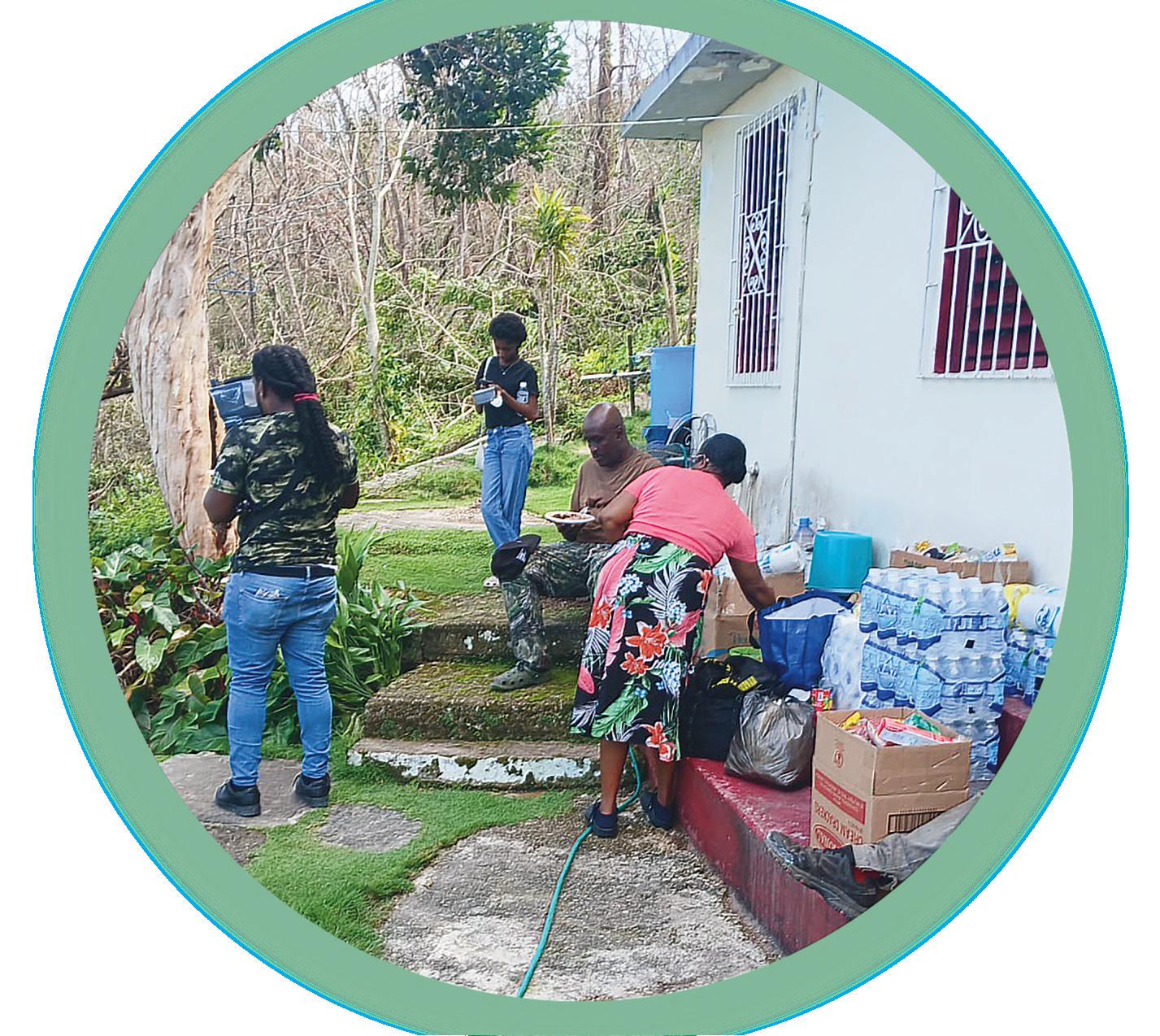


affected, she knows her people and country will recover from this and get stronger.
Not only Jamaicans, but every person can contribute and help each other, especially in difficult situations and be grateful to be alive.
“I feel like as people we should just really pull together and to see that one nation is struggling and just be able to appreciate



Political polarization is increasing among Canadians, affecting their ideologies and social circles.
Assistant Professor of political science at the University of Toronto, Eric Merkley, said in a Humber President’s Lecture Series speech on Oct. 30 that affective polarization is the growth of warmth toward one’s own political party while growing hostile feelings toward the opposition and their supporters increase.
Political polarization is the further divide of competing parties with wider boundaries between “us and them,” Merkley said in the lecture.
According to a 2019 University of Toronto study, affective polarization has increased by more than 126 per cent.
In the study, 25 per cent of people said they showed no warmth toward an opposing party in 2019
However, only four per cent of people had zero warmth in 1993.
The study said the change in political issue beliefs and ideology played a role in the polarization of the nation.
Liberals, Conservatives and the NDP have taken a stronger stance on modern political issues, Merkley said.
Humber Polytechnic Liberal Studies professor Blake Lambert said politicians have taken stronger stances to win the polarized vote, and the stances taken are a reflection of individual party supporters.
Merkley said the more polarized issues are mostly because of the reformed party funding initiatives under the Conservative Stephen Harper government from 2006 to 2015.
“The problem is that it’s a story about elites, it’s a story about politicians,” he said.
Merkley said citizens conversing with people who share opposing views may tame polarization among citizens if handled respectfully, but it is not enough to change the polarized stances of the major parties. It is up to the current funding system, which relies on smaller donations from polarized voters.
tory than they need to be than they were in the past.”
Polarization motivates people to protect and defend their political identity and worldviews, leading to less socializing with opposing party supporters, Merkley said.
actions, Merkley said.
Forty-two per cent of people are comfortable with a prime minister of their own party refusing to resign after an election defeat if they claim election irregularities, and that number drops to 18 per cent when the prime minister is a political opponent, the study said.
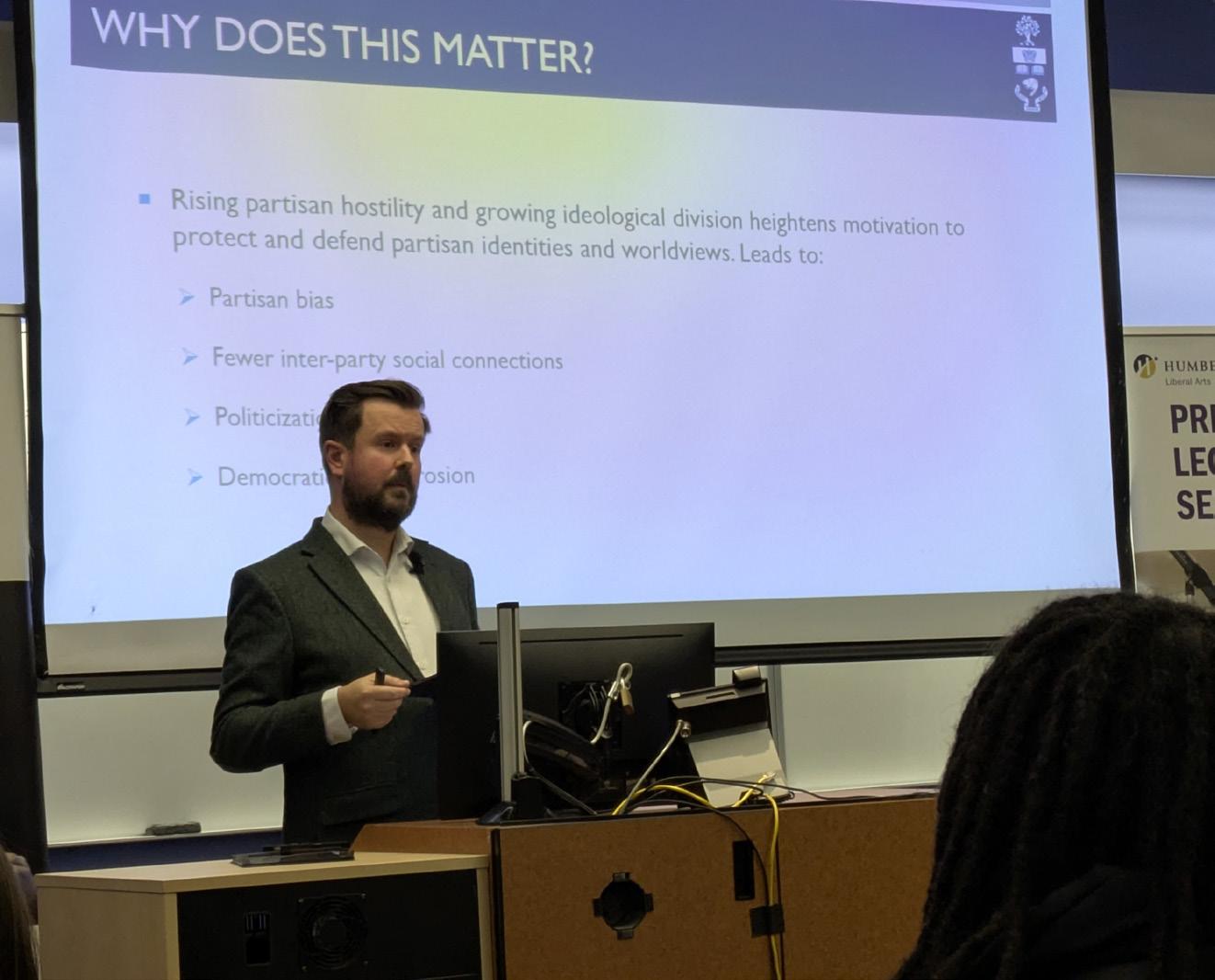
Among polarized individuals, 64 per cent would support this action from a prime minister of their party, while 10 per cent would support the same action from an opposing party’s prime minister.
cocooning themselves in social networks of like-minded individuals, Merkley said in the lecture.
Between 21 and 23 per cent of party supporters said they’re uncomfortable with neighbours, friends, or in-laws who support their political opponents, the University of Toronto study said.
This percentage rises to 33 and 40 per cent for those with high levels of polarization and drops to 13 and 15 per cent for those with low levels of polarization.
Merkley said the primary solution is a change in rhetoric and strong stances among politicians. However, people can do their part by engaging with opposing supporters from an understanding perspective.
Professor Alyson Renaldo brought her English class to the lecture to improve their understanding of the political landscape and engage in the importance of Canadian politics.
Merkley said that the blame shouldn’t be on the citizens but on the system that incentivizes and rewards polarized rhetoric.
“People that donate to political parties in small amounts are very, very ideological and very, very polarized,” he said. “We’ve created a system of incentives that encourages politicians to be much more toxic and much more inflamma-
Socially distancing oneself from an opposing party supporter is similar to other groups who are discriminated against, including Muslims and members of the LGBTQ community, the University of Toronto study said.
“People typically stay in their silos and don’t think of perspectives beyond their immediate ones,” Lambert said.
Motivation to protect and defend political commitments can lead to support for anti-democratic
Less polarized individuals remain equally supportive of this action at 38 and 39 per cent.
Polarized individuals reflexively reject or accept information quickly depending on its political leanings, Merkley said in the lecture.
The University of Toronto study said 66 per cent of polarized people preferred a news story that supported their political beliefs.
Polarized people protect their political identities and beliefs by
“What we’re primarily seeking to have students learn here is how to not only be good at their craft but also how to be good citizens,” she said. “Understanding how to take your place in this world, in our Canadian society and gaining insight into what that looks like is part of the educational process.”
Humber student Emmanuella Owusu said she thought the lecture was extremely relevant for broadening her horizons, but wouldn’t change the way she interacts with opposing supporters.
“I’m always going to speak my mind,” she said. Although “there’s nothing to speak to them about.”
Anew food place opened up in the LinX Lounge that caters to all different diets.
Tita’s Forn is a family-owned restaurant that has recently opened up at Humber Polytechnic North campus.
“It’s a family business,” said Paul Iskander, director of ancillary services at Humber. “It’s like a father, a mother, a daughter, and a son, and I like the family more than the corporate.”
They serve a wide variety of food options for everyone’s food needs, but no one’s here because it’s hidden in LinX Lounge, and not a lot of people go there, or no one knows that it’s there.
The food options include
chicken shawarma, chicken souvlaki, sandwiches, salads, veggie chow main, lentil soup, veggie burger and steak. And they have
choose a restaurant, but in the school, then make sure it can cater to everybody,” Iskander said.
offered at Humber has a chance to succeed at Humber Polytechnic.
“So, for example, he can’t

vegan and gluten-free options available.
“That’s one of the major points that you guys choose when you
For instance, they want to make sure they don’t take away from other businesses by making sure everything that is being
serve pizza because we have pizza pizza,” Iskander said. “He can’t serve Mexican because we already have a Mexican place. He
can do bubble tea, for example, because we have a bubble tea place.”
Architecture technology student Rose Akbas said she discovered the diner when she went to LinX to shoot pool.
“I got a chicken shawarma,” she said. “It was really good. I liked it a lot.”
Abdula Saeed and Syed Ahmed, both Mechatronics engineering students, have been coming to LinX Lounge since the beginning of the semester to hang out, shoot pool and play table tennis with their buddies, and they have seen restaurants being switched out.
When they saw Tita’s, they knew they had to try it, and both decided to order the chicken fajitas.

A sign indicating a bike lane begins is on a street in Toronto, leaving students and cyclists debate over the future of cycling infrastructure, and if signs like this will be an ancient
Laura Rodgers HumberETC News
Industrial design student at Humber, Ayan Abdullah, said she is often worried for her own safety on the road without bike lanes.
“There needs to be way more bike lanes,” she said. “Students can’t afford cars, they can afford a bike, maybe.”
Premier Doug Ford’s government’s new Bill 60 would prohibit municipalities from removing or narrowing existing car lanes to create dedicated cycling infrastructure.
Ontario’s Ministry of Municipal Affairs and Housing announced this proposal in Bill 60, the Fighting Delays, Building Faster Act, on Oct. 23.
Cycle Toronto’s executive director, Michael Longfield, said he couldn’t help but laugh every time he thinks about the bike lane proposal in Bill 60.
“I don’t know if they were hoping that people wouldn’t be aware or that the rental pieces would drown out the bike lane piece or vice versa,” he said. “It’s a fairly cynical piece of legislation.”
University of Toronto data sciences professor, whose work focuses on bicycle infrastructure, Madeleine Bonsma-Fisher, said Bill 60 will affect a lot of plans for
building a cycling network.
“The push to remove bike infrastructure or block bike infrastructure, especially on main roads, is really harmful to the creation of a cycle network,” she said.
Longfield said the polling Cycle Toronto has done has shown that people are supportive of bike lanes.
“Despite the fact that it’s often framed like a broader culture war,” despite seven in 10 Torontonians supporting building protected bike lanes, he said.
Bonsma-Fisher said main roads are often the only roads that go to places people want to go to and the removal or ban of bike lanes would affect that.
She said it makes sense to go down to two lanes where there are four-lane roads to make way for cyclists, despite Bill 60 proposing to ban it.
“Many people just don’t have a driver’s license, and so this kind of ignores that whole huge section of the population that doesn’t have to have equal access when we prioritize driving,” Bonsma-Fisher said.
Abdullah said that as a student, she can’t afford a car, but she could maybe afford a bike.
She said she was worried about the cyclist population decreasing if Bill 60 passes.
“I believe that bikes would get less and less, people wouldn’t have
safe places to go,” she said. “The amount of road rage that would happen.”
Humber Student Ayan Abdullah, as a cyclist, is frustrated with Bill 60. “We already favour cars here,” she said. “We are not even on the same level.” Humber ETC/Laura Rodgers
Bonsma-Fisher said she could see a win-win for everyone by taking “a four-lane car road, making two lanes for cars, two lanes for bikes, parking, turning lights, everything else.
“So you’re not losing access, right? You’re not losing anything for cars, and in fact, when people who don’t need to drive have options, traffic will get better overall,” she said.
Abdullah said even if cars saw the creation of bike lanes as a negative decision, she feels her life is worth the inconvenience.
She said she is a person who cycles to save money and take care of the environment, so without bike lanes, “you’re doing everything right and getting nothing in return, except endangerment.”
She said she has had a few close calls with cars while on her bike.
“Cars just don’t pay attention,” Abdullah said.
Tech design teacher at West Humber Collegiate and lifelong biker, Patrick Collins, said his
sense of the city is from a bike seat.
He said the current bike lanes in Toronto are not planned out well.
“The way it’s been done is really goofy,” Collins said. “The fact that it’s been done? It is really awesome. They’re heavily used.”
Collins said he will go out of his way to take bike lanes because he feels safer on them.
Bonsma-Fisher said biking is among the best ways to move people from one place to another.
“If they were thinking about efficient movement of people, all signs point to transit and cycling and walking as being the way to efficiently move people,” she said.
The City of Toronto did a pilot test by creating bike lanes on Bloor Street West, from Shaw Street to Runnymede Road, from 2016-2017.
It said the average total traffic volumes on Bloor Street West decreased 16 per cent.
The city said in 2020 and 2021, motor vehicle volumes went down an average of 24 per cent after the full implementation of the bike lanes.
“It’s like a win-win. You get more people biking, they feel safe, but you’re not seeing any kind of negative impact on traffic,” Bonsma-Fisher said.
“It’s not clear to me that they are making these types of policies based on information and data,
and a clear understanding of how those things relate,” she said.
Bonsma-Fisher said Bill 60 seems to be motivated by political goals “and the sentiments of people who tend to vote for them.”
Collins said Bill 60 is supposed to be about building housing, “and what he’s done is add this anti-cycling thing on as an afterthought.
“That’s the impression I get from what I’ve read,” he said.
Ford said at a media conference on Sept. 23, 2024, that not allowing a bike lane when a lane of traffic has to be taken out would not decrease congestion is “hogwash.”
He said there are only four or five bikes on the road, while cars are backed up for kilometres.
“We have to focus on transportation to get people from point A to point B in quick fashion,” Ford said. Longfield said banning bike lanes can sound like a good solution, but it’s not based on any data.

When most people hear their phones blast out sirens for the latest Amber Alert, reactions are often mixed. Some people glance at the notification before tossing their phone aside. Others mute their device with no questions asked.
But this sense of apathy only distracts people from the actual problem at hand: children being kidnapped, and police needing assistance to make sure the child is safe.
It’s even more concerning that the future of the public alert system is now uncertain. An access to information request retrieved by Canada’s National Observer discovered that the funding agreement for the National Public Alerting System, or Alert Ready, was set to expire on Aug. 31, 2026.
There are currently no plans to extend the contract, something that Public Safety Canada is concerned about. This was detailed in a memo to the minister of emergency management.
“Urgent action is required to sustain Canada’s life-saving public alerting capability,” it said.
Alert Ready doesn’t exist for only Amber Alerts. It also acts to send alerts out for extreme weather, air quality, wildfires, and other threats. Yet, this is not how much of the population views the system. Instead, it’s treated as a nuisance to one’s everyday routine.
This universal apathy only hides the actual news on hand. For instance, two weeks ago, Ontarians around the GTA received an Amber Alert for a 17-month-old baby who was kidnapped by her mother’s ex-partner. The mother, Savannah Kulla, was found shot at the scene after her ex-partner fled.
A press release published by the Niagara Regional Police Service said that the suspect, Anthony Deschepper, fled to Niagara Region before engaging in a standoff with police. They said an “interaction with offi-
cers” left Deschepper dead at the scene. The 17-month-old was found at a family member's house.
Yet, that wasn’t what people took away from the incident. Instead, the videos trending on social media were focusing on poking fun at the situation. Many were complaining about the sudden noise disrupting their day-to-day routines.
A video published on TikTok by user @ itsmur_ blew up not long after the Amber Alert sounded off. He pretended to look at his phone before throwing it aside dramatically.
These attitudes only detract from the actual problem at hand. For instance, in response to this news, MP Frank Caputo took to social media X to highlight the lack of legislative reprimand when it comes to domestic abuse cases.
"Why are we not passing Bill C-225 forthwith? I wrote this bill to address the pernicious issue of IPV," he said in a post.
Caputo is referencing Bill C-225, a private member's bill he tabled recently in hopes of addressing the root issues in IPV, or Intimate Partner Violence, and strengthening intimate partner laws. It's something we wouldn't even know of, if not for actual proof playing out in the news as to why we need laws like this, something an Amber Alert brought to light, yet was dismissed as annoying.
Additionally, the only reason Peel Police were able to find the 17-month-old so fast was because of the Amber Alert.
Ontario Provincial Police said in a press release that 90 per cent of Amber Alerts have resulted in the safe recovery of the missing child. For instance, an Amber Alert was issued for an eight-month-old last August, and was found 20 minutes later thanks to the alert.
So next time you hear your phone blaring its familiar siren, maybe you should pick it up and give the news a read instead of throwing your phone aside.




When I was younger, Halloween was a legendary holiday.
The constant rain that would appear dampens the spirits of kids every year, or the range of costumes, ghost-shaped sugar cookies, and teachers playing "It’s the Great Pumpkin, Charlie Brown," the ultimate classic.
But in recent years, there has been a noticeable lack of spirit. The homes that used to be lit up with giant witch inflatables and creepy clowns have now become dull houses in neighbourhoods that do not embrace their community.
The spirit of the holiday used to be about unity. Kids wearing brightly coloured jackets and parents chatting on the driveway, waiting for us to get our handfuls of candy, now they’re barely outside.
It’s as if Halloween has lost its spark.
To me, the holiday feels more transactional. The parental standpoint is now the influx of money, where costumes and decorations have gotten increasingly expensive, and the basic act of trick or treating is being replaced with what is referred to as “trunk or treat.”
National Public Radio reports says “trunk or treat” is an alternative to trick-or-treating, in which guardians gather their vehicles in one spot, usually a parking lot. They open their trunks and give out candy.
Driving around my neighbourhood is when I first noticed the spiritual decline in the holiday. Each house lacked Halloween decor, and Halloween inventory still filled the shelves and racks at the stores.
I feel as though kids who used to want to live in the present moment are more focused on what time their Halloween party is, as
opposed to their costume contest held in their school cafeterias.
There's a lack of thrill that comes with this holiday. There's no late-night candy swaps or sneakily eating a Twix bar that your parents have yet to check. It’s not the same as when I was a kid.
It feels as though there is a disconnect in neighbourhood dynamics. The older I get, the more significant the change becomes that separates the older generations from the younger. My almost five-year-old nephew has yet to carve a pumpkin. Although this may not seem important, to me, it is a staple for the holiday, an important part of growing up
It’s an experience that reminds me of the first “Diary of a Wimpy Kid” movie.
It was nice to watch how Rowley and Greg mapped out their town to try to get the largest candy bars.
These childhood experiences are something my mom appreciates.
“When they’re younger, you definitely want to entertain them and keep them active and keep them going on a level that allows them to experience different things in their life,” my mom says.
But hearing her say this makes me realize that this kind of hands-on effort feels more uncommon now.
With parents seeming more inclined to hand their kids tablets to scroll on TikTok instead of creating a space where they can enjoy neighbourhoods and get their rain boots muddy, it is ruining them.
For me, it is merely a constant reminder that media that caters to their age range is more about being perceived as older, as opposed to being able to participate in Disney Channel’s Monstober and Family Channel doing Halloween makeovers.
I feel as though children lack a “tween” awkward stage that is a major part of their developmental process, skipping over all the fun and quirky activities we were able to engage in during this time.
It’s not only about the costly decorations and the lack of watching classics, it's now the nostalgia that's tied to the holiday and watching it slowly disappear in front of my once excited eyes.
K'Leeanna Marriot, she/her, is a news reporter at Humber Et Cetera. She covers news, environmental issues and arts.

October was a month of fundamental acknowledgement for Filipinos and Palestinians. For Filipinos, the month is observed as Peasant Month, which is ded
following the ceasefire.
Similarly, the Negros famine was sparked during the wind-down of the martial law under Ferdinand Marcos. Negros is a Philippine island best known for its sugar production. However, after the international price of sugar dropped exponentially in a market crash, numerous sugar workers lost their jobs, resulting in the majority of sugar planters going bankrupt. Due to the collapse and reliance on sugar as the only source of agricultural income, many families experienced
earliest sites of human life, appearing in scriptures as early as the 5th Century BCE, making it more than 2,000 years older than the start of the Zionist movement in 1882.
With the Zionist government's agreement to
the partition, but the Arab leaders' rejection, this sparked the Israeli-Palestinian conflict.

which is roughly 7.5 million households. This is the highest it has been since the COVID-19 pandemic.
In August, the United Nations-backed global hunger monitor declared that Gaza is experiencing famine due to the Israeli blockade preventing access to essentials. An Integrated Food Security Phase Clas sification (IPC) survey found that one of the main contributing factors to the Stage 5 catastrophe is food system col lapse. According to a survey by the United Nations, half of Gaza households say access to food hasn’t improved or has worsened
Having intersecting issues such as famine born through sovereignty were horrific, but they kick-started anti-militarist movements, with peasants as the force behind it. This September, the State of Palestine was declared its own sovereign state by the United Nations, with 157 countries recognizing it as such. Howrecognized pines in it one of bers of the acknowlchange United Palession of lands,
With the Philippines and other countries acknowledging Palestine early, it has contributed
current acknowl edgement as a state. Though politically, the Philippine govern ment has been far from perfect when it comes to its own issues and Pal estine, it's the Filipino peasants who have one of the loudest voices globally on the issue.
The Filipino proletariat has consistently held protests and vigils, speaking out against Palestinian recent one City, groups LAKAS, tion and organion prothey nalists assas -


ippines, Mounir Y.K. Anastas, said that both countries experienced imperialism, but that Palestine is still enduring colonial occupation. He identified that, though Jerusalem is sacred in many contexts, this issue is far from religious. This isn’t just a simple act of solidarity, and neither are many other human rights alliances. Many are born through political and ethical sagacity, and the intersection of their issues, like famine and land reform.
Activism has reigned strong in the Philippines for decades. One in particular stands out to me. Robyn Magalit Rodriguez is an and has -
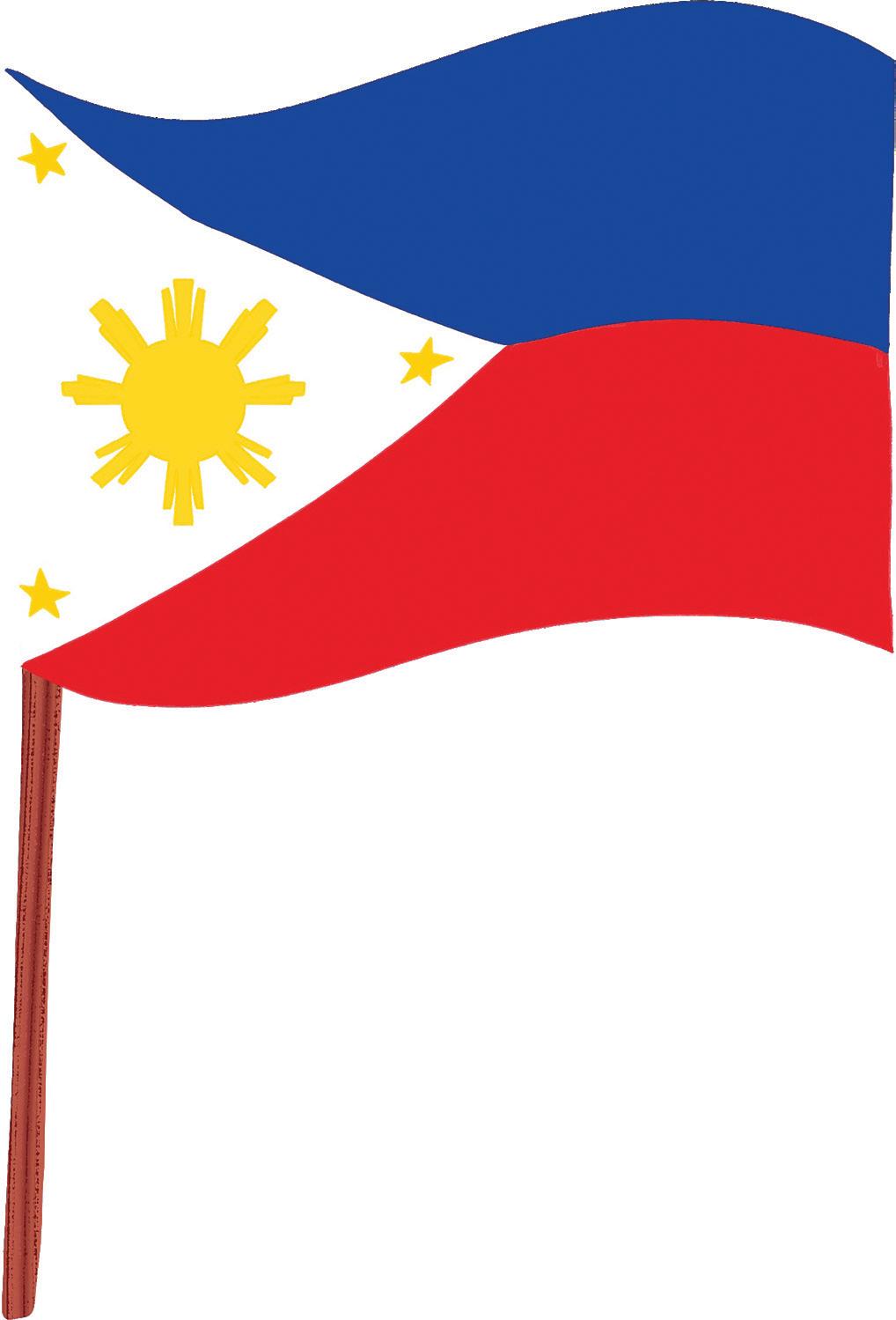
In a meeting at the Palestinian Embassy in the Philippines, the Pales-
no-Palestinian solidarity. Her course is a step for people in solidarity with Palestine. She has marched alongside Palestinian activist groups for decades and is also a mentor with the Association of Asian American Studies (AAAS), which passed an anti-war resolution. Inspiring the Boycott, Divestment and Sanctions Movement (BDS) to endorse the
“The adoption of this resolution by the General Membership of the AAAS is precedent-setting. This is the first time that a professional association of academics anywhere outside the Arab world adopts such an unequivocal resolution in support of the boycott of Israeli academic institutions,” BDS said in a statement.

Though genocide and government corruption are very different crises, the peasants of both countries have faced dispossession. The union of their voices has made a difference in educating the public on the heinous war crimes and injustices Palestinians are facing.
Solidarity isn’t only about saving people's lives. It's saving their nations.
Julia C. Sequeira, she/her, is the opinion and editorial editor at Humber Et Cetera. She covers culture, lifestyle and social issues

Emma Randall HumberETC Culture
Humber Polytechnic community members say Indigenous visibility, language revitalization, and marketplace participation are key parts of cultural engagement and reconciliation on campus.
Aaron Sykes, a curriculum and pedagogy specialist with Indigenous Education and Engagement at Humber Polytechnic, and a member of the Kanien’kehá:ka originally from the Quinte, Ont. area, and a member of the Wolf Clan, said representation needs to be a part of all of Humber’s offerings.
“We need to incorporate Indig-
enous ways of knowing and being across all departments and faculties at Humber, not just the liberal arts and sciences,” he said.
Sykes said Indigenous languages play a critical role in reconciliation.
“Our whole epistemologies, world views, and points of view and our stories are really in our language, language, language, language, always helps to revitalize,” he said.
“It’s really, really important to have role models for young Indigenous people, to see Indigenous people in positions of authority and power, like associate deans and deans and faculty,” Sykes said.
At the Indigenous marketplace on Tuesday, Nov. 4, the Humber Library had a pop-up with books written by Indigenous authors with stories about all the various Indigenous cultures.
Stephanie Clark, a library staff member, said most people don’t even know that the library has Indigenous authors.
Clark said the books were chosen through Humber’s library guides to highlight Indigenous perspectives and storytelling.
“Anyone who comes to the Indigenous pop-up can check out any of these books,” she said.
The event also featured a handful of local artists and vendors.
Kay Chan, also known by their Instagram handle MakeSomething.K, was one of those vendors selling a myriad of art.
“As a maker of things, I need to make sure it is moving in a way that is being seen by others. This is a great way to be on the ground – physical space of being seen versus just another data cell on the internet,” they said.
Chan said markets usually bring in sales, but school-based events vary.
“Sometimes school-based markets can be a hit or a miss,” they said.
“Student income is a bit more focused on living versus cute little things, but if you’ve got a couple
of bucks to spare for a cute little thing that makes you smile or just a little touch of culture, why not?”
The Indigenous Education and Engagement team hosts events such as the marketplace and the upcoming Indigenous knowledge gathering on Nov. 12 to 14 at both Lakeshore and North campuses.
Sykes said that this kind of student and community involvement contributes to a broader goal of reconciliation.
“Any amount of reconciliation is a good amount of reconciliation, imagining ourselves now in the present or in the future is a resistance to colonialism, asserting our present here and now in the future,” he said.
Parthvi Indravadan Patel Senior Reporter
The Recital Hall at Humber Lakeshore’s cultural hub was filled with music students and enthusiasts on Wednesday afternoon as JUNO-nominated singer, trumpet player, and songwriter Tara Kannangara led a lively masterclass on songwriting, creativity, and life in the music industry.
As part of Humber’s music masterclass series, the event let students learn from a professional artist who mixes jazz, indie, and pop. With jazz keyboardist Chris Pruden, Kannangara showed how songs develop from an idea to a finished piece.
During the session, Kannangara performed some of her unreleased songs and explained her writing process, instrument choices, and lyrical ideas.
She also spoke about the challenges and rewards of being a full-time musician in Canada’s competitive music scene.
Kannangara discussed balancing creativity with the business side of the music industry.
She said that artists need to handle their own work, branding, and promotion while staying true to their art.
“I try to be as honest as possible in my music,” Kannangara said. “It’s about finding what you want to say and saying it in your own way.”
Kannangara said making music takes not just talent but also discipline and persistence.
The masterclass also talked about how mindset and environment affect creativity. Kannangara encouraged students to take breaks from social media to let new ideas grow.
Bachelor of Music student at Humber Lakeshore, Simone Hope, said the session was both inspiring and down-to-earth.
“It reminded me that creativity doesn’t discriminate. It can be cultivated by anybody,” Hope said. “Tara showed us that staying true to your own voice while also allowing growth
is what leads to the best results.”
Hope said hearing from a real musician helped her see how what she learns in class connects to real life.
“It’s different when you hear it from someone doing it,” Hope said. “It made me realize how important it is to create a space that helps your creativity grow.”
Humber’s music department often hosts masterclasses to show students different music styles and careers.
Mentors want students to connect class learning with real-world experience.
Kannangara’s visit gave students useful tips and a better understanding of songwriting. The hall was relaxed but focused, with students taking notes, asking questions, and sharing their own challenges.
“It was the productive class, as I got the chance to learn many new things sufficiently,” Hope said.

Tara Kannangara and Chris Pruden are performing for the masterclass.
The best part for students was watching Kannangara and Pruden perform. Their teamwork showed the skill and emotion she had talked about.
By the end, the audience felt inspired. The masterclass showed Tara Kannangara’s artistry and helped students understand how to grow their own creativity.
Samul Vari, a third-year student of music at Humber Lakeshore, said the
free event was open to all Humber students and community members, with standing-room-only attendance showing the popularity of workshops that mix performance and learning. “It wasn’t just about music, it was about learning how to be an artist,” Vari said.
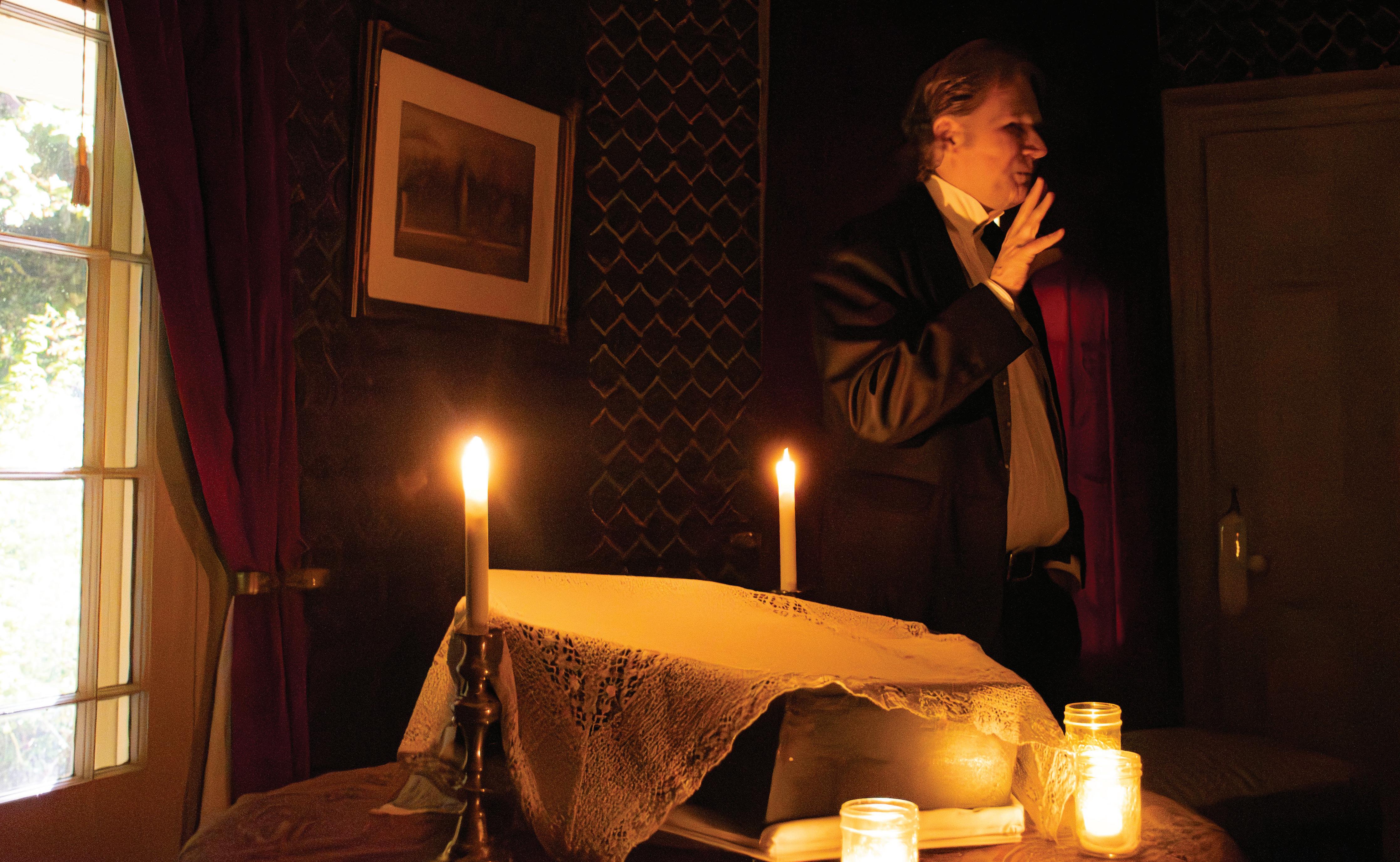
Olivia Masztalerz HumberETC Culture
People who visit Colborne Lodge at Halloween come to see if it is haunted. But the bonus of touring the building built in the 1800s is learning about the legacy of the Howard family.
Architect John George Howard built Colborne Lodge in 1837 in High Park. He lived there with his wife, Jemima Howard, until he died in 1890, when the house became the property of the City of Toronto and was developed into High Park. For the last few years, the lodge, now a museum, has hosted an After Dark program.
The program is called After Dark Tours: The Unexplained at Colborne Lodge.
Bruce Beaton, acting coordinator of Colborne Lodge programs and who helps run the lodge, led this year’s tour on Thursday, Oct. 30.
Beaton said the purpose of historical house tours is to encourage people’s curiosity about the past.
“One of the overwhelming questions we are asked again and again and again, when people are doing the normal historical house tour
of this place, is: Is it haunted? So, our attempt to satisfy that visitor’s curiosity is what a program like this is about,’’ he said.
“I also believe that at this time of year, people come to a place like this because they want to know if there’s any proof, any real proof, of any activity on the other side of the spectral divide,’’ he said.
Participants’ interest in old houses being haunted allows his organization to teach the history.
“They’ll come here and they’ll learn about the people who lived here and some of the knowledge of the history of this place, and then we share with them stories of things that might indicate there is a spiritual presence enduring in this structure,’’ he said
Beaton discussed the Howard family story and the British immigrants’ efforts to build a new life in Upper Canada. Beaton said that John came from Britain before he came to the Colborne Lodge.
“John was the first professionally trained architect in Upper Canada, so he was very busy when he got here,” Beaton said.
But still, Howard found time
to design Colborne Lodge for his own home and moved in with his wife Jemima in the winter of 1837.
The Howards changed their names, and thus their identity, to make themselves seem more aristocratic, he said.
’When they left England in 1832, they had a different last name, Corby. When they arrived here, they changed their last name to Howard to make themselves sound more aristocratic than they actually were,’’ he said.
Beaton explained the significance the British class system would hold for a family like the Howards.
“British class structure is rigidly enforced, primarily around who your father was, sometimes your mother. But primarily your father would actually dictate where you sat in this very rigid British class structure,” he said. “So, they just reinvented themselves when they got here to make themselves sound a little more aristocratic than they actually were.’’
Beaton leaves the true tales of the paranormal activities mysterious. He says he doesn’t want to give any spoilers for the tours.
He said that although the tour doesn’t promise participants the stories of the 1800s, it does detail the lives of the Howards.
“They only came here in 1832, so this tour tells us nothing about the year 1800. It does tell us a little bit about people who lived through the 1800s because John himself died in this house in 1890. But they didn’t arrive here till 1832,” Beaton said.
He said people in the 1800s had a closer relationship to death and dying than people do today. Death was closer for the Howard family because, generally, people died at their homes in the 1800s instead of in hospitals.
“One thing it tells us is that death was closer to every day human experience than it is now,’’ he said.
‘’Most people died at home, and they were set up for people to come and pay their last respects in the home, which is what happened here.’’
Beaton spoke more about the mysterious connection between death and the afterlife and Colborne Lodge’s experience with that. A “few things’’ did happen in the house, but they don’t offer
much of an answer about the death and afterlife.
He said that a few things that can’t be explained if someone thinks they saw a ghost or spirit.
“That’s the mysterious question of the universe. I don’t know. You have to decide for yourselves. And people come here to consider that for themselves,’’ he said.
Uliana Webster was on the house tour and said she was pleasantly surprised by the event.
‘’Honestly, it wasn’t what I thought it was going to be. I didn’t expect it to be like this, like on a good note,’’ she said.
Nikki Arkadia, also on the tour, wanted to see for herself, without any spoilers. She admits she didn’t read the description of the event.
“I didn’t want to read about it because I wanted to be surprised, and it was good,’’ she said.
Shane Anne Sabarillo, who joined the other two, said she recommends the tour to those who are interested in events that mix history and hauntings.
“Oh, yeah. I would (recommend it) if you’re into history and haunted stuff, and adventures. Yeah, something spooky, definitely,’’ she said.

The dominance of American teams in the Major League Soccer (MLS) doesn’t look as guaranteed for the current season.
Of the three Canadian teams playing in the MLS, it’s the Vancouver Whitecaps who are looking solid in the playoff rounds of the 2025 season. CF Montreal and Toronto FC failed to make the playoffs.
Canadian teams in the MLS went through a rough time the past couple of seasons, and while some of them made it to the playoffs, none of them advanced far.
The last significant run by a Canadian team came from Toronto FC when they reached the MLS final but fell short against the Seattle Sounders in the 2019 season.
Two years prior, Toronto made history as the first and only Canadian team so far to be an MLS champion when they defeated Seattle 2-0.
But now, it’s the Whitecaps who are looking to be the next team to join the list, and they have shown merit for at least moving far into the playoffs.
The current season couldn’t have been better for the West Coast team.
In the Canadian Championship, a domestic competition, the team
lifted its fourth consecutive trophy of a total of five after beating Vancouver FC in the final 4-2. It also qualified the Caps for the Concacaf Champions Cup, where they reached their first final in history by knocking out big North American teams on their way, such as Monterrey, Pumas and Inter Miami.
Unfortunately, they lost by a 5-0 rout in the final against Cruz Azul, marking a bitter end to their dream continental run.
The Caps closed out the regular season second in the Western Conference, just behind San Diego FC, which they tied in points with 63, but because San Diego won more games than the Caps, they claimed the top of the conference.
At one point, Vancouver notched a 14-game unbeaten streak in all competitions. In MLS, their longest streak was nine games.
Both their defence and offence performance were superlative, especially in the Western Conference.
They were the Western Conference team with the greatest number of goals scored in the MLS, with a total of 66, putting them in third behind Inter Miami's 81 and the 68 goals by the Chicago Fire. The Caps also had the fewest goals conceded in the west, with a total of 38, and second in the MLS, just behind Philadelphia Union with 35 goals.
The Whitecaps' squad's display of football has left fans since the start of the season amazed by their quality and strength. It was a significant turnaround of performance thanks to Danish coach Jesper Sørensen, who joined the team in January.
He changed the team's chemistry and strengthened the players’ quality from last year, when the team ended with 47 points in the eighth position
in the regular season.
Signings such as Germany's World Cup champion Thomas Müller made their contribution since the first game, getting the armband and becoming the team’s captain.
With the playoffs already underway, the Whitecaps qualified for the MLS quarterfinals after knocking out Dallas FC in two games to win the best-of-three series 2-0.
They are set to face Los Angeles FC in the next round, looking for revenge from last season when the team was eliminated by Los Angeles in the round of 16 in the 2024 season. It’s looking closer than ever to seeing a Canadian team fighting for the gold.
Samuel Brito, he/him, is the environmental editor at Humber Et Cetera. She covers environmental issues and sports.

Three countries host the 2026 World Cup for the first time, but the United States' political and economic influence makes its participation as a host a concerning choice.
FIFA's slogan, “Football Unites the World,” seeks to bring everyone together as one, fostering peace, inclusivity and unity.
However, American actions contradict these intentions, particularly with travel bans affecting countries participating in the World Cup, such as Iran. Sport Business Journal reported the U.S. State Department denied visa requests for Iranian officials attending the draw in Washington, D.C.
The spirit of the World Cup is betrayed when a host nation decides who is welcome into the country based on political tensions. Indeed, Human Rights Watch urged FIFA to take steps to safeguard the human rights of those who attend the World Cup matches in the U.S. when it
begins in June.
Rights organizations fear that Immigration and Customs Enforcement (ICE) will show up at World Cup games.
“Despite FIFA’s mantra that ‘football unites the world,’ a World Cup held under discriminatory and exclusionary policies risks deepening social divides rather than bridging them," said Andrea Florence, executive director of the Sport and Rights Alliance, a global coalition of leading rights organizations. "FIFA should exert its leverage and demand concrete, legally binding guarantees that human rights won’t be further sacrificed for the sake of the game.”
While the United States continues to have ongoing problems, its co-hosts, Canada and Mexico, offer a different example of FIFA’s meaning.
According to Statistics Canada's 2021 Census of Population, immigrants make up 23 per cent of Canada’s population. Canada’s multicultural identity and its peaceful, stable political environment and reputation for safety, according to the 2024 Global Peace Index, make it a symbol of unity for the tournament.
Many players representing the country come from immigrant backgrounds. From Alphonso Davies, who was born in a refugee camp in Ghana to Liberian parents before moving to Canada, to Jonathan David, whose parents emigrated from Haiti, it reflects the idea of inclusion that reflects FIFA’s mes-
sage, as well as the team's representation of the country’s mixed cultural identity.
The U.S. is the wealthiest of the three hosts, with a GDP of about US$29.2 trillion in 2024. However, high ticket prices and travel expenses in the country may limit international fans from travelling. Out of the 16 host cities for the tournament, all but five are in the U.S., making it more of an American-led event than an equally shared World Cup.
As a result, the U.S. receives most of the tourism and financial benefits, hosting 78 matches, while Canada and Mexico each have 13.
The 2025 Club World Cup, which was also hosted in the United States, featured many high-profile matchups, but many also saw large numbers of empty seats in stadiums, with ticket prices being low. The group stage average attendance was about 34,759, which filled up about 57 per cent of stadium capacity according to a Sports Business Journal report. The attendance rate would partially increase in the later rounds as some world’s biggest clubs were still in the competition.
As one of the three hosts, the United States seems more focused on profit and its image than on creating an inclusive experience for fans
worldwide. The World Cup should represent celebration, connection, accessibility and not involve political tension and economic barriers that exclude people from the tournament.
FIFA’s promises of unity face issues as the 2026 World Cup approaches. The U.S. has the resources to host the tournament, but with political tensions, travel bans, safety concerns at venues, and the high ticket price, the slogan “Football Unites the World” may not hold to its word.

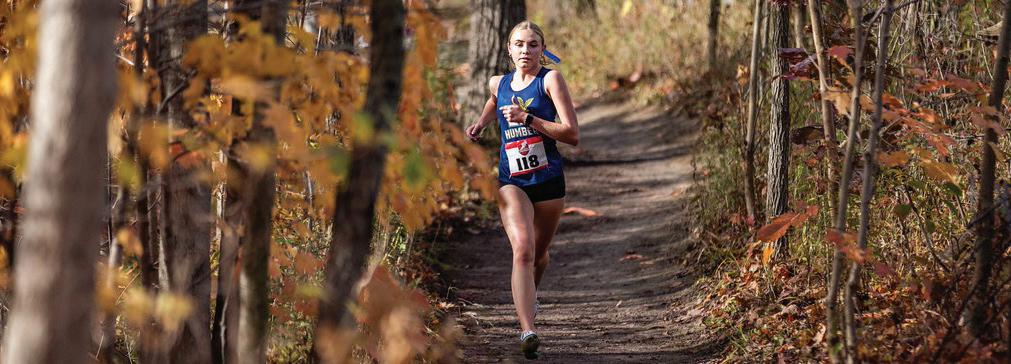
Humber Hawks women’s cross country won gold at the OCAA championship race in Hamilton
Matthew Ziniuk Senior Reporter
The Humber Hawks cross country program had an outstanding showing at the Ontario Collegiate Athletic Association’s provincial championships in Hamilton on Oct. 25.
The women’s team captured gold, marking Humber’s first OCAA title in 10 years, while the men’s team finished fifth overall after a competitive day of racing at Marydale Park.
The team now turns its focus to the CCAA National Championships in Prince Edward Island,
where they’ll compete for another podium finish on Nov. 8.
It was a historic win for the women’s squad, which secured the championship with an impressive total of 39 points, led by standout performances from veteran and rookie runners alike.
Veteran Catherine Irwin capped her final OCAA race with a third-place finish, helping lead Humber to the top of the podium.
“I’m so proud of this team,” Irwin said. “We’ve worked all season to build this chemistry, and to see it come together like this feels incred-
ible.”
Rookie Jenny Hartnell also made a major impact, finishing seventh overall and placing among the top first-year runners in the entire field.
gold-medal group.
“This win means a lot to all of us,” Irwin said. “We’ve been chasing this moment for years, and everyone gave everything they had out there.”
nationals, while Joshua Pascoe finished 16th, narrowly missing out despite a personal best performance.
The rest of the women’s lineup helped seal the championship win.
“I’M SO PROUD OF THIS TEAM”
- Catherine Irwin
The men’s team faced a tough field, placing fifth overall behind Sheridan, Fanshawe, St. Clair and Mohawk after a tight race.
Skylar Allsopp, Christina Serrano, and Zoë Collat each finished strong to contribute key points, while Sofia Peña Castillo rounded out Humber’s
Lim Bauman led the Hawks with a 14th-place finish, earning second-team All-Ontarian Honours and a berth at the nationals.
Chino Rodney followed closely behind in 15th, also qualifying for
Kyle Obico, Jaivir Sandhar, and Jean De Grano-Lacroix rounded out Humber’s strong men’s lineup with determined finishes in the provincial final.
Both Bauman and Rodney will represent Humber at Nationals, joining the women’s team in Prince Edward Island on Nov. 8 to close out their season.
“This is just the beginning,” Irwin said. “We’re ready for nationals and want to show that Humber belongs among the best in Canada.”
Toronto’s first-ever championship Game 7 ends in heartbreak as the Dodgers capture back-to-back championships
Matthew Ziniuk, Ethan Alcaidinho Senior Reporters
The Toronto Blue Jays were three outs away from their first World Series title in 32 years, but the Los Angeles Dodgers stunned them in extra innings last Saturday night.
Although the championship series fades, the pain and the disappointment over the outcome linger.
“I feel absolutely devastated,” Humber student Cameron Grouse said. “Especially with (pitcher Jeff) Hoffman selling it. They had so many chances to come back. It was just not great. I’m sad.”
The Dodgers earned a 5-4 win in the first-ever championship Game 7 in the Blue Jays’ franchise history, in the 11th inning. The West
Coast team captured back-to-back championships for the first time since 2000.
But some found pride in the team’s resilience throughout the season. The Jays finished last in the American League East last year, but they bounced back to win the AL pennant.
“It was pretty tough,” Humber student Sean Zellman said on Nov. 5. “They were so close so many times. But honestly, as a big Jays fan, I was just happy to be there.”
Reese Velocci, a Humber student, shared similar optimism.
“They weren’t supposed to make it this far anyway,” she said. “As a Jays fan, it was awesome to see them go as far as they did.”
The heartbreak felt familiar to Humber student Dennis Golovatch, but it was still inspiring.
“A lot of chances to close it. It
just embodies Toronto and its sports scene,” he said. “There’s always next year, supposedly.”
TTC rider Jada Lavelle said she was “feeling sad and disappointed, that’s it.” She was among the countless Jays fans who believed this was their year.
Julia Medeiros, another disappointed fan, said, said she was sad at the outcome, but she remains hopeful “we can bring this back next year and win it all.”



Everyone on Humber’s softball team pitched in right down to the wire to finally bring home the gold.
Humber Hawks outfielder Rilee Rothwell said she was extremely excited for the opportunity to be in the gold medal game and possibly win again.
Rothwell said this season has been the best one the girls have had in a while, despite dropping seven straight in the middle of the season.
The Humber women’s softball team captured its fourth gold medal at the Ontario Colleges Athletic Association (OCAA) finals, defeating the St. Clair Saints 9-2 on Oct. 18 in front of their home crowd at Connorvale Park in Etobicoke.
The team ranked third in the conference when they arrived at the final, with a record of 16-9 in the regular season.
Head coach Duaine Bowles said even though the girls had a tough season, he was extremely proud they were able to “battle back from the depths of despair.”
Bowles, in his ninth season with the team, said he gives credit to St. Clair, who got this far even with a new coaching change.
The Saints, who came out of the gates red-hot, were able to capture the first game 12-1 against the Hawks at home.
In the second match, the Humber hoped to come back, knowing rookie Maddy Friesen would make an appearance on the hill, who was locked in from the dugout.
Friesen, who later went to bat at the top of the fourth, smashed a three-run homer, increasing her squad’s lead to six.
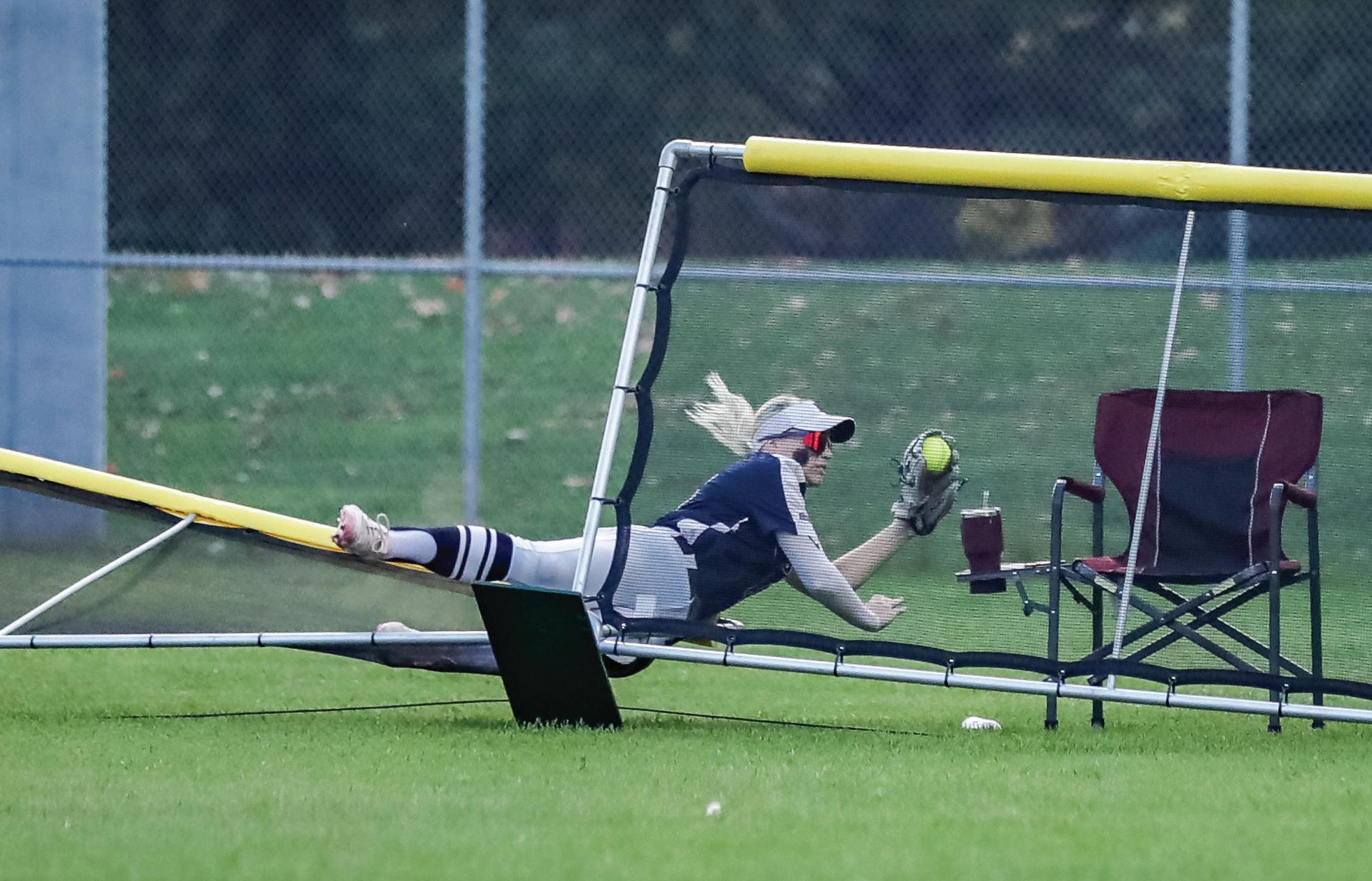
The Altona, Man., native said she was glad she could contribute in more than one moment to help her team secure the victory.
“I was pitching, but I was giving them a lot of work, I was giving them ground balls, fly balls to catch, and they were helping me out a whole lot,” Friesen said.
Also recognized as OCAA All-Rookie, she recorded four RBIs in this match and ranks second in the OCAA with a 2.10 ERA.
Rothwell stood out on the team as well, making her the biggest contribution to the game in the bottom of the sixth, flying over the fence to record the final out of the inning, as the crowd looked on in awe.
The Cambridge, Ont., native was also named OCAA Player of the Year. Rothwell said the recognition by the league was the cherry on top of this season.
Rothwell led the OCAA in batting with an average of .489 in 24 games played and was named the 2025 batting champion.
Bowles also commends Humber softball alumna Hayley Pasma for sending the message to the coaching staff that the process cannot be the same for every group because everyone is different.
In the end, the Hawks kept this message in mind to close out the game on a 9-2 win with whatever energy they had left.
As for what’s next, everyone on that team strives for the same goal: to make the improvements and tick the last box off their list, winning a national gold at the Canadian Collegiate Softball Association (CCSA) National Championships.
To do this, Bowles said the girls need to get better in the circle and make sure those who are doing well continue to become the best versions of themselves.
Marco Moretto HumberETC Sports
Once seen as just a hobby, esports has exploded into a billion-dollar industry worldwide. For many fans, the way they follow their favourite esports teams feels nearly identical to how others follow hockey, football, or basketball.
Many key factors led to this rapid rise in esports viewership and participation.
“The major factors that have contributed most impactfully to the insane explosion we see in the viewership of esports are ultimately the ability to view esports,” said Geoffrey Lachapelle, an esports academic who now teaches at Humber.
Esports have been around for more than 30 years. When they were first gaining steam, the main problem was the difficulty in finding a way to stream the games. The invention of the app Twitch allowed fans to actually watch live for the first time.
“When Twitch formalized and fully became a thing around late 2010, early 2011, that is directly in line with the explosion in popularity and viewership of esports,” Lachapelle said.
Twitch allowed fans to not only watch live for the first time, but with elements introduced, such as chat, that created participation and engagement. With big-name games such as League of Legends, Counter Strike and Dota heading to Twitch, it created growth and a couple of years later led to sponsorships, which brought the money and allowed them to scale, Lachapelle said.
A large difference between esports and traditional sports is the streaming aspect. Esports are streamed on free platforms like YouTube and Twitch, compared to tradi-

tional sports, where you have to subscribe and pay for multiple different streaming services just to see your favourite team play.
In 2024-2025, the Premier League pulled in $1.68 billion in sponsorship revenue compared to esports, which garnered $726 million in sponsorships in 2024, and a projection of more than $1 billion for 2025, according to a report in esportsinsider.com.
“I think esports is following exactly the same trajectory as sports. Which is why we call it esports,” Lachapelle said. “We call it esports because the competitive and monetary structure is very close and the viewership structure very closely resembles that of
classical athletic sports.”
Over the years, there has been a debate on whether esports are real sports.
“I wouldn’t say it’s a real sport, but it’s still an activity which promotes competitiveness and the need to adapt to different situations,” said Dumitru Gortolomei, a Humber student who is in game programming.
Between streaming, sponsorships, viewership and business models, the similarities and differences show.
“I believe it’s becoming more like traditional sports, but in a few years’ time, it may start carving its own path,” Gortolomei said.
Sports and esports already are showing
similarities with viewership, media rights and event organization.
“I think there is already overlap as esports continue to scale. You already see it being mentioned and getting nods from major television networks,” Lachapelle said. There is only room for growth in esports, with projections growing every year and with the Olympics potentially taking esports more seriously, there will be a big shift, not exactly in tech but in the public perception, he said.
“Streaming is the be-all and end-all and the way it changes how the audience really works,” Lachapelle said.

Denny Luong Humber ETC Sports
The Hawks men’s volleyball team won its home opener and held a special milestone ceremony on Nov. 1.
Men’s head coach Wayne Wilkins gathered with his family after the men’s game, including his brother Chris Wilkins, who coaches the women’s team. Players and alumni in attendance wore T-shirts featuring his face to highlight his 30th season with the Hawks.
Reflecting on his future with the Hawks, Wilkins said he isn’t sure how long he will keep coaching, but he still feels the same passion as when he started.
“I've been asked this a number of times, [and] I don't ever know,” he said. “But I will say this, I love it. My heart is here."
“As long as I can get out of bed and stay motivated to come into the hallways and push these guys, as long as they'll have me, I'll probably stay,” Wilkins said.
The ceremony highlighted the men’s game on Saturday night against the Redeemer Royals, with the Hawks winning four of the five meetings before the game.
Historically, this was Wilkins’ first team he faced at home in his inaugural season. The game ended with Humber winning a 3-0 set sweep on Nov. 9, 1995. Before the game, Wilkins said he expected a tough match against the Redeemer.
“These guys always put out a great competitive team on the court,” he said. “We have to use the experience that we do have in our starting lineup, we have to use it to our strength.”
“Stay disciplined, try not to get too high [or] too low and continue to use our strengths, and I think we’ll be fine,” Wilkins said.
Humber took the lead in the first set with first-year outside hitter Enzo Endres getting the first kill of the game.
The Hawks maintained the lead throughout the game.
Humber extended its lead to 19-12, prompting a timeout by the Redeemers.
Players like Teyven Blackmore, Kyle Gray-Phillips and Endres played an important role in the team's seven-point gap.
Redeemers would eventually bring the score closer, but it wasn’t enough for them to come back, as Humber won the set point after a Redeemer player committed a net violation. The second set saw Humber fall behind in the early stage but eventually came back. It was another back-and-forth between the teams.
The Hawks would take the lead back against the Redeemers with Blackmore securing the set-point with a kill to win
set two with a score of 25-18.
In the third set, Humber struggled to take the lead.
The Hawks would fight back in the near end of the set, but a possible comeback could not happen as the Royals took the win 25-22.
Humber brought momentum heading into the fourth set, taking the lead and increasing the gap to as high as seven points. The game would be sealed after a service fault from a Royal player, giving the Hawks their second win of the season.
After the game, Blackmore, who earned Player of the Match, said the team's message after the third set loss was to stay mentally strong and focused.
“It was really just mental, a lot of it was the focus,” he said. “We go one, two points without scoring, or without siding out, and then we kind of get a little bit down in the dumps.
“It's just about remembering it's not done,” Blackmore said. “If you want to pick it up, it's just a choice.” For rookie player Endres, he recorded a career-high 19 points, with 16 kills, two service aces and nine digs.
“I think it was my best performance yet on this team,” he said. “[I] hope getting better every day.”
With the win, the Hawks are 2-1, sitting in sixth place in the OCAA Western Conference as of Nov. 5.
Humber will look to continue its winning momentum against Conestoga at home, who are 3-1.
Wilkins said the Condors will be a tough matchup for the Hawks.
“Big game, they always push hard against us,” he said. “I think we're going to get back to the drawing board and start, you know, making sure that we're ready
and prepared for them.”
“The reality is that I know we're a good team, but they are too, and so as long as we stay disciplined and stick to our game plan, I'm confident we'll be successful,” Wilkins said.
Blackmore said the team plans to maintain its momentum heading into practice for next week's game.
“We'll carry it over to practice,” he said. “Keeping that energy that we had on the court in the practices, keeping the momentum, [and] making sure we're staying focused at times that we need.”

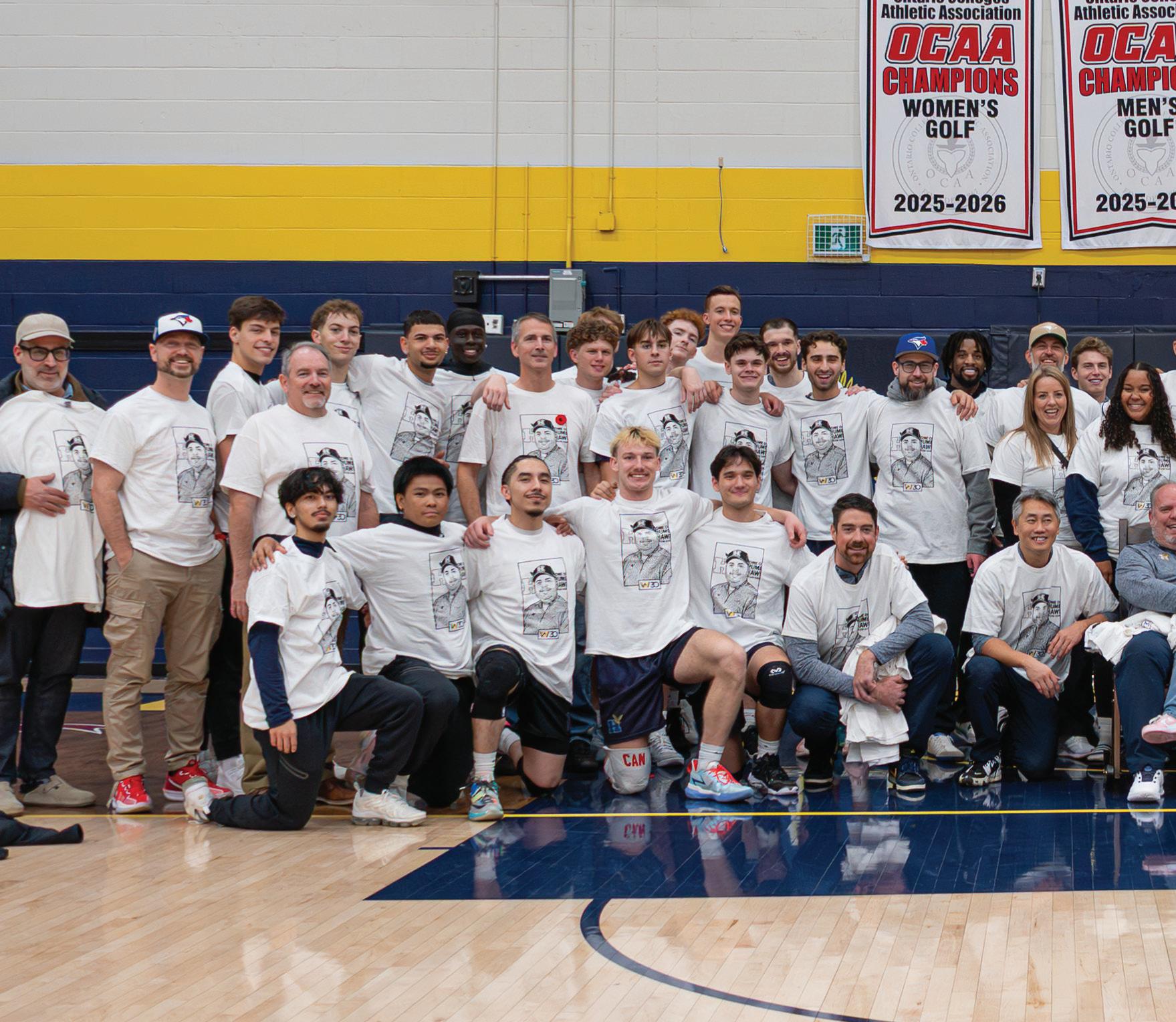

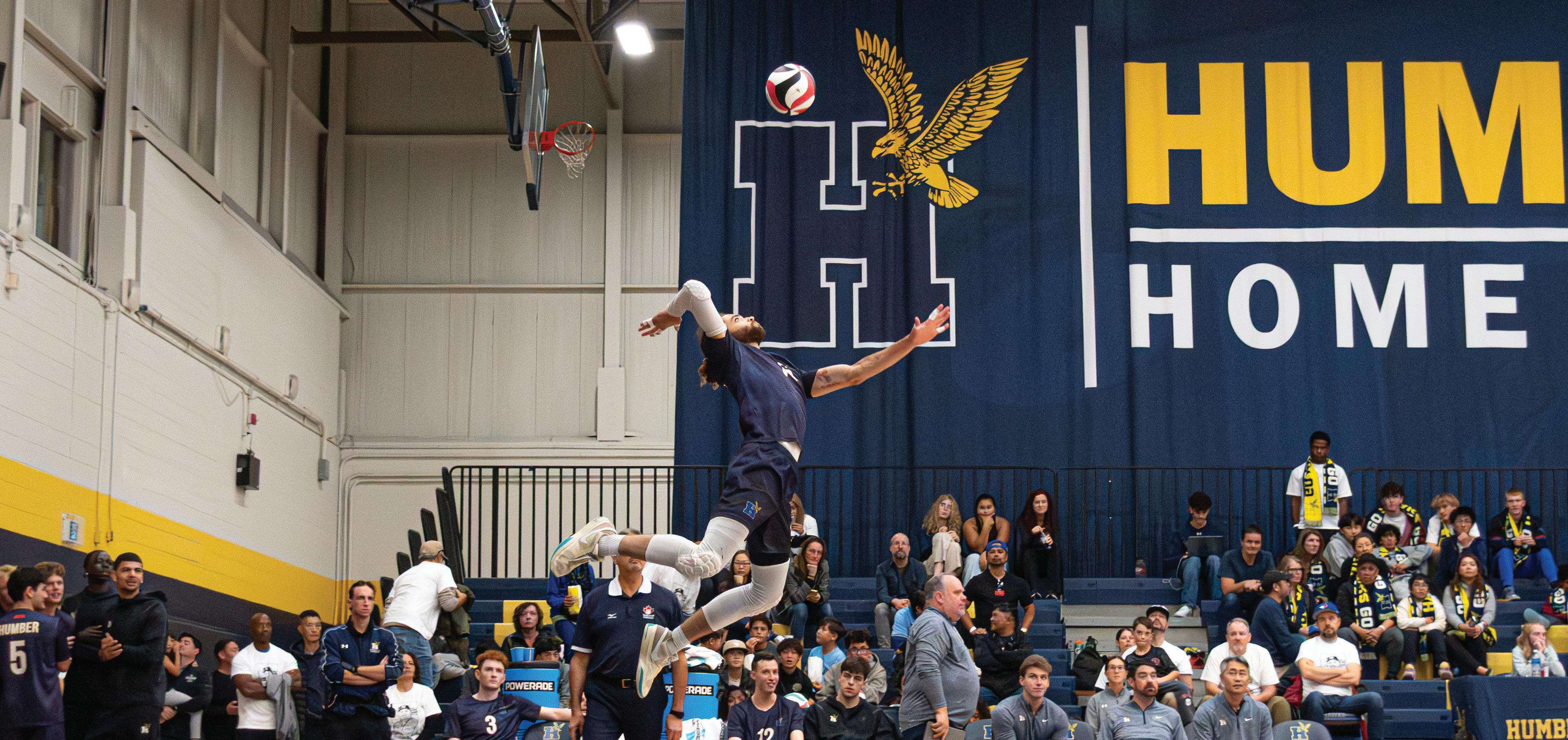

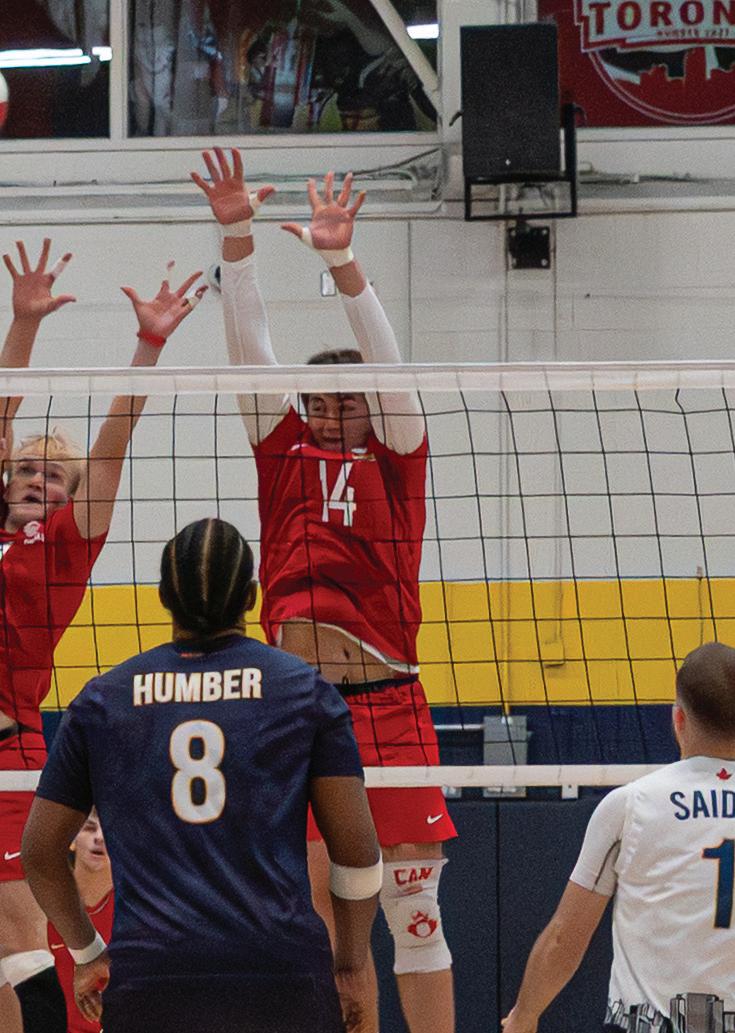
Denny Luong Humber ETC Sports
Humber’s women’s volleyball team swept the Sault Cougars in their Nov. 1 home opener in the Ontario Colleges Athletic Association (OCAA) match on Saturday.
This was the Hawks' first meeting against the Cougars since 2011. The Hawks swept them on Jan. 1 that year.
Head coach Chris Wilkins said the return of the Cougars is exciting, as they are back in the league after more than a decade.
“They're a competitive team already in their first year, which is great,” he said.
“One of my former players is actually one of the coaches over there, which is awesome.”
“Obviously, we're going to try and give them a good run today, but it's exciting,” Wilkins said.
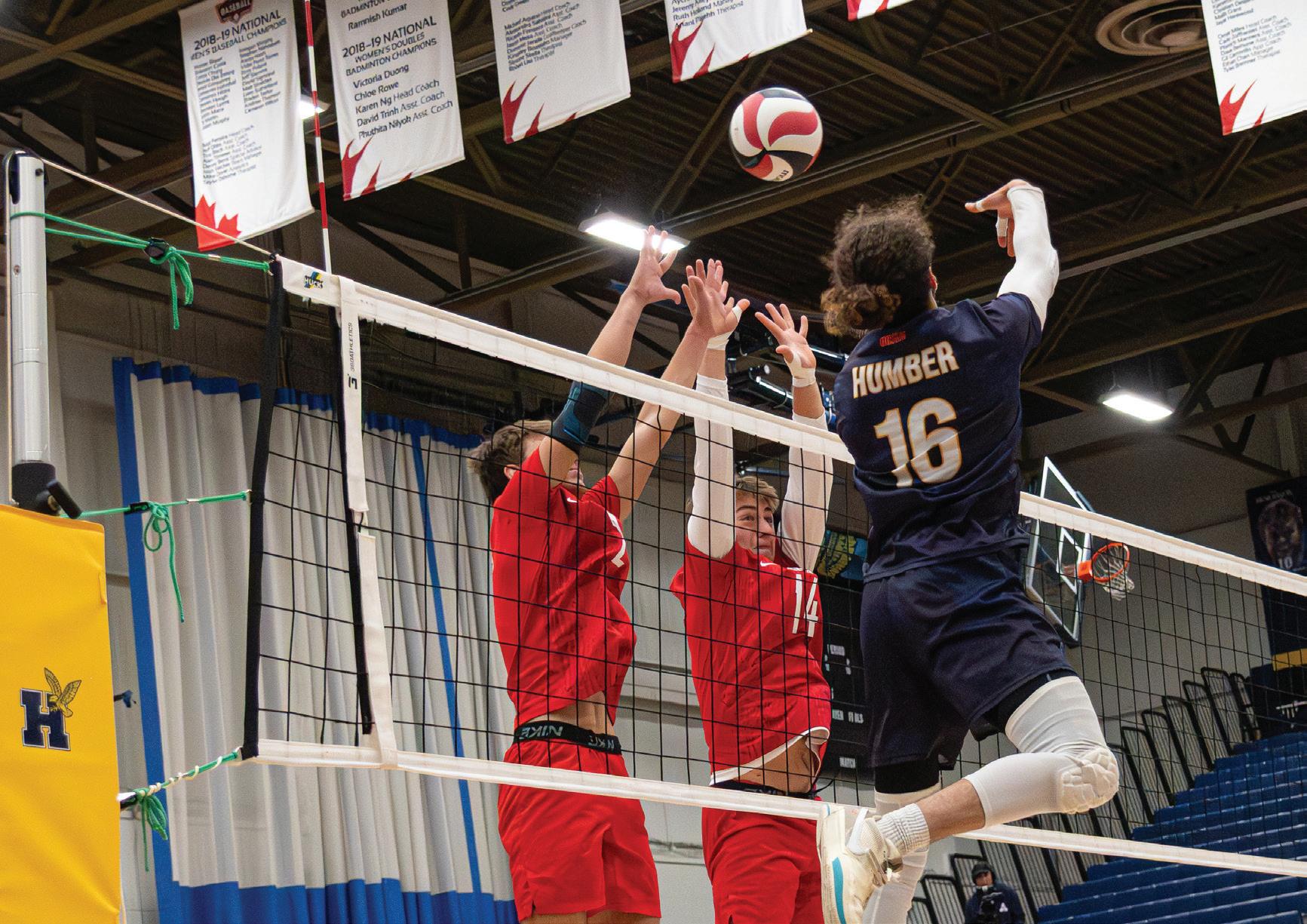
The Hawks struggled in the first set, as they were trailing, but eventually took the lead at 17-16.
Despite a timeout call by Sault, the Hawks maintained the lead and would secure the set win 25-22 after first-year setter Jessie McDonaugh served up a service ace. The second set saw Humber dominate the game with fifth-year outside hitter Lexie Zicari delivering five service aces in the round. They would win the second set 25-9 with third-year Lexi Sabo serving the set-point kill.
This was one of the Hawks' best performances of this new season, preventing Sault from reaching
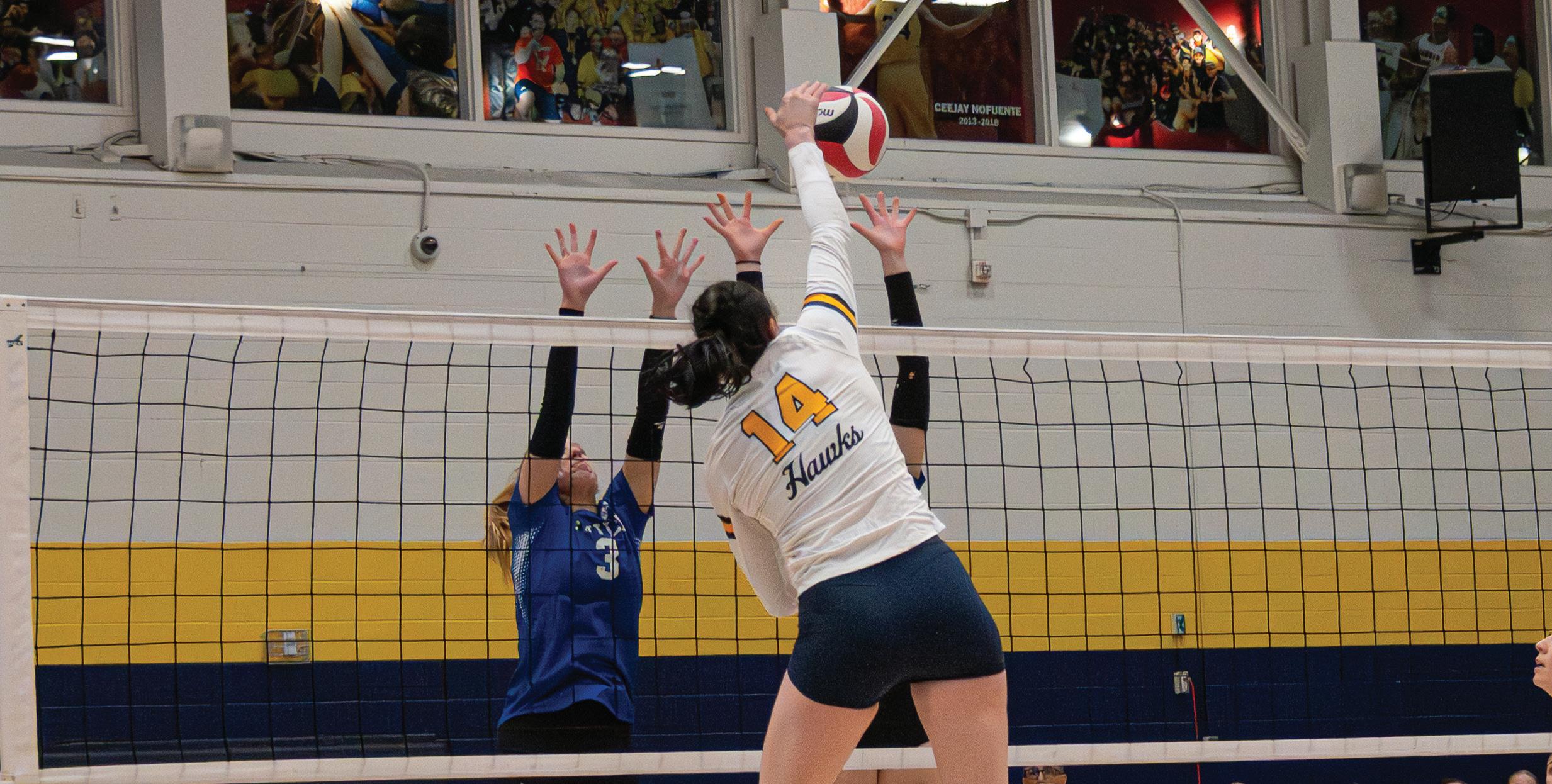
double-digit points. The last time Humber brought a team to only a single-digit point in a set was against the Boreal Viperes on Oct. 18, 2024.
The third set would be the same story as the Hawks dominated the whole game and

would secure the win 25-13.
This extended Humber’s home opener sweep against OCAA teams to 14 seasons in a row. The last time the Hawks failed to pull a sweep set win in their home opener was against the Niagara Knights, a 3-1 result in the 2011-'12 season.
After the game, first-year middle blocker Faith Hughes said the team's energy and preparation showed throughout the match.
“We did really well considering this was our first home opener,” she said. “We've been working super hard in practice on little things.”
“I really think that we put that out there, our serving was really good, we were all super aggressive, and I love this team so much,” Hughes said.
Chris said he was proud of the early impact that his rookies made in the game.
“Faith [Hughes], obviously, she's going to be a big part of our team, and she did (really) good tonight,” he said. “Our firstyear setter, Jessie [McDonaugh], did a good job coming in and really kind of controlling the offence.
Humber also played against Sault on Sunday, where they won the game in a sweep 3-0.
Following that game, the Hawks are now undefeated with a 4-0 record in the OCAA Western Division.
Humber will face the Conestoga Condors, who are 3-1 at home on Nov. 12, with the first serve set to begin at 6 p.m.
